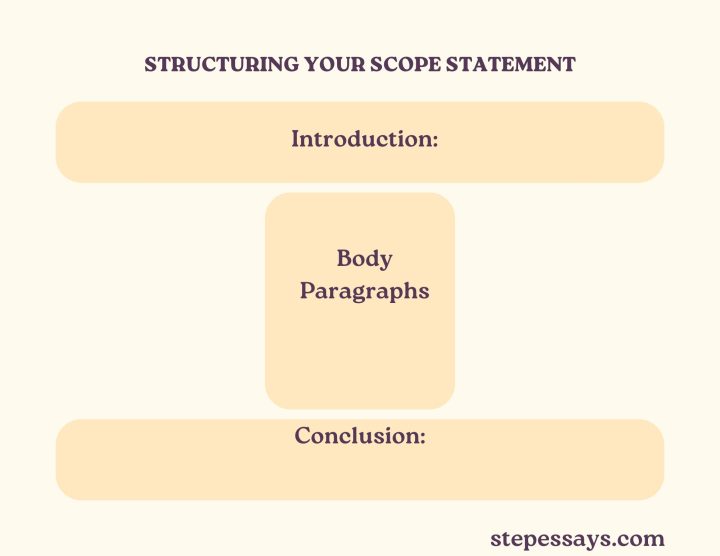Introduction
The scope statement is a foundational document in project management that outlines the objectives, deliverables, boundaries, and constraints of a project. It serves as a roadmap for project teams, stakeholders, and sponsors, ensuring everyone is aligned on what the project will accomplish and how it will be executed. Crafting a well-defined scope statement is critical for project success, as it helps prevent scope creep, establishes clear expectations, and guides decision-making throughout the project lifecycle. In this comprehensive guide, we will look deep into the complexities of structuring a robust scope statement, covering everything from its purpose and components to best practices and examples.

Scope of Statement
1. Understanding the Purpose of a Scope Statement
Before diving into the intricacies of structuring a scope statement, it’s essential to grasp its purpose within the project management framework. The scope statement serves several key functions, including:
1.1. Defining Project Objectives
It articulates the overarching goals and objectives of the project, providing clarity on what the project aims to achieve.
1.2. Establishing Deliverables
It outlines the specific deliverables or outcomes that the project will produce, helping stakeholders understand what they can expect upon project completion.
1.3. Setting Boundaries
By delineating the boundaries of the project, including what is included and excluded, it helps prevent scope creep and ensures focus on essential tasks.
1.4. Clarifying Roles and Responsibilities
The scope statement identifies key stakeholders and their roles in the project, fostering accountability and collaboration among team members.
1.5. Managing Expectations
Clear communication of project scope helps manage stakeholders’ expectations regarding project outcomes, timelines, and resource requirements.
2. Components
A well-structured scope statement typically comprises the following components:
2.1. Project Justification
This section provides a rationale for undertaking the project, outlining the business need or opportunity it addresses.
2.2. Objectives
Clearly defined project objectives describe the desired outcomes or results that the project aims to accomplish.
2.3. Deliverables
A list of tangible products, services, or results that the project will deliver to meet its objectives.
2.4. Scope Description
A detailed description of the project scope, including what is included and excluded from the project.
2.5. Assumptions
Assumptions are factors or conditions that are considered to be true for the purpose of planning the project but are not guaranteed to be accurate.
2.6. Constraints
Constraints are limitations or restrictions that may impact the execution of the project, such as budget, timeline, or resource constraints.
2.7. Stakeholder Identification
Identification of key stakeholders and their roles and responsibilities in the project.
2.8. Approval Requirements
Criteria and procedures for obtaining approval of the scope statement from relevant stakeholders.
3. Structuring Your Scope Statement
Structuring a scope statement involves organizing the components in a clear and logical manner to ensure readability and comprehension. Here’s a suggested structure:
3.1. Introduction
- Provide an overview of the project.
- Briefly explain the purpose and importance.
3.2. Project Justification
- Present the business case for the project.
- Explain why the project is necessary and how it aligns with organizational goals.
3.3. Objectives
- Clearly state the specific, measurable, achievable, relevant, and time-bound (SMART) objectives of the project.
- Ensure that objectives are aligned with the project justification.
3.4. Deliverables
- List the tangible outputs or results that the project will produce.
- Describe each deliverable in sufficient detail to facilitate understanding.
3.5. Scope Description
- Define the boundaries of the project.
- Specify what is included and excluded from the project scope.
- Use clear and concise language to avoid ambiguity.
3.6. Assumptions
- Document any assumptions that have been made in defining the project scope.
- Clearly state the potential implications if these assumptions prove to be incorrect.
3.7. Constraints
- Identify any constraints that may impact the project’s execution.
- Specify how these constraints will be managed or mitigated.
3.8. Stakeholder Identification
- List key stakeholders involved in the project.
- Define their roles and responsibilities.
- Include contact information for each stakeholder.
3.9. Approval Requirements
- Outline the process for obtaining approval of the scope statement.
- Specify who has the authority to approve.
4. Best Practices for Crafting a Scope Statement
To ensure the effectiveness consider the following best practices:
4.1. Involve Key Stakeholders
Engage relevant stakeholders in the development of the scope statement to gain consensus and buy-in.
4.2. Use Clear and Concise Language
Communicate the project scope using language that is easy to understand and free of jargon or technical terms.
4.3. Be Specific and Detailed
Provide sufficient detail in describing project objectives, deliverables, and scope to avoid ambiguity.
4.4. Define Acceptance Criteria
Establish criteria for determining whether project deliverables meet stakeholders’ expectations and requirements.
4.5. Review and Revise Regularly
Periodically review and update the scope statement to ensure it remains aligned with project objectives and stakeholders’ needs.
4.6. Document Changes
Document any changes to the scope statement and obtain approval from relevant stakeholders before proceeding with implementation.
5. Examples of Scope Statements
To further illustrate the concepts discussed, here are two examples of well-structured
5.1. Example 1: Software Development Project
[Provide a sample scope statement for a software development project, including project justification, objectives, deliverables, scope description, assumptions, constraints, stakeholder identification, and approval requirements.]5.2. Example 2: Construction Project
[Provide a sample scope statement for a construction project, including project justification, objectives, deliverables, scope description, assumptions, constraints, stakeholder identification, and approval requirements.]Conclusion
Crafting a well-structured scope statement is essential for defining the parameters of a project and ensuring alignment among stakeholders. By understanding the purpose, components, and best practices of scope statement development, project managers can effectively communicate project scope, manage expectations, and drive project success. By following the guidelines outlined in this comprehensive guide, you can create a robust scope statement that serves as a roadmap for project execution and delivery.
